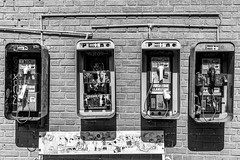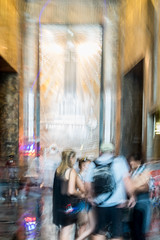This is my contribution to this Week Photo Challenge: Jubilant
This scene was taken in Times Square (NYC) a few months ago.
The Queensboro Bridge, also known as the 59th Street Bridge – because its Manhattan end is located between 59th and 60th Streets – and officially titled the Ed Koch Queensboro Bridge, is a cantilever bridge over the East River in New York City that was completed in 1909. It connects the neighborhood of Long Island City in the borough of Queens with Manhattan, passing over Roosevelt Island. It carries New York State Route 25 and is the westernmost of the four East River spans that carry a route number: NY 25 terminates at the west (Manhattan) side of the bridge, which once carried NY 24 and NY 25A as well. The bridge is flanked on its northern side by the freestanding Roosevelt Island Tramway. The bridge was, for a long time, simply called the Queensboro Bridge, but in March 2011, the bridge was officially renamed in honor of former New York City mayor Ed Koch.
More info: Wikipedia
Lower Manhattan, also known as Downtown Manhattan, is the southernmost part of the island of Manhattan, the main island and center of business and government of the City of New York, which itself originated at the southern tip of Manhattan Island in 1624.
Photographs taken on september 4, at 19:47
More info: Wikipedia
Reflections on Photography by Henri Cartier-Bresson
 “Manufactured” or staged photography does not concern me. And if I make a judgement it can only be on a psychological or sociological level. There are those who take photographs arranged beforehand and those who go out to discover the image and seize it.
“Manufactured” or staged photography does not concern me. And if I make a judgement it can only be on a psychological or sociological level. There are those who take photographs arranged beforehand and those who go out to discover the image and seize it.
For me the camera is a sketch book, an instrument of intuition and spontaneity, the master of the instant wich, in visual terms, questions and decides simultaneously. In order to “give a meaning” to the world, one has to feel oneself involved in what one frames through the viewfinder.
This attitude requires concentration, a discipline of mind, sensitivity, and a sense of geometry -it is by great economy of means that one arrives at simplicity of expression.
One must always take photographs with the greatest respect for the subject and for oneself.
from The mind’s eye.
Writings on Photography and Photographers by Henri Cartier-Bresson (1908–2004).
Do you agree with Cartier-Bresson?. Maybe you agree on some things. I like his words but I am not so strict in some ways. I recognize that the great French photographer had thought a lot about his photography, its justification and meaning. And his photography was consistent with the way he saw it. But I admire a lot of people who “take photographs arranged beforehand”. In photography, I think there is room for all styles and I love a good photography whatever style. We’ll talk more about it soon.
Today’s photography it is not an easy photo, it isn’t a beautiful flower or a wonderful landscape, but for me it could be a good photo, if it weren’t for the average photographer. ..
Dark Landscape
We turn to a different theme. Today I upload this picture of a bleak landscape, but relaxing at the same time.
This dark but interesting landscape has given me some moments of relax and peace. They are mountains of my country, Catalonia (north-east Spain).
I hope that you enjoy seeing them. as I did.
Today we play with scale: we use human silhouettes to help convey size in this image.
The Soul of the Ebro (El alma del Ebro) was created by Jaume Plensa i Suñé Read More












































